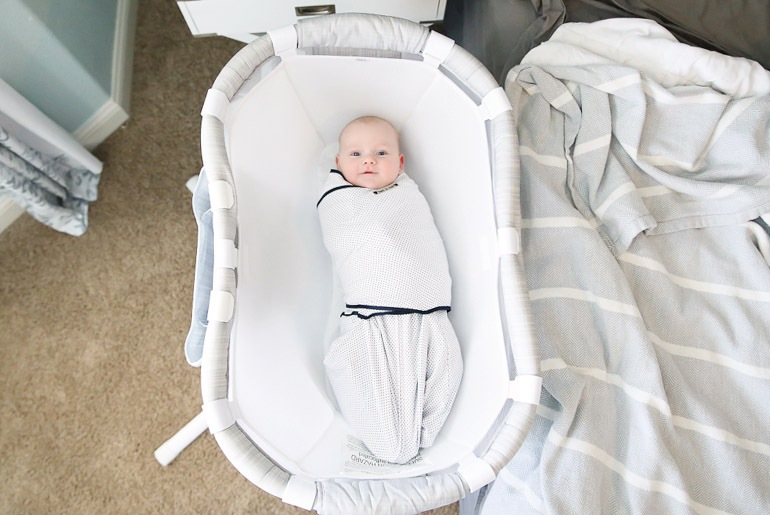Disclaimer: There are affiliate links in this post. At no cost to you, I get commissions for purchases made through these links.
When your newborn screams in her bassinet, the first thoughts that come to your mind are, What happened? Is the bassinet mattress too hard, and my baby feels uncomfortable with it?
This topic seems challenging, but the solution is simple: newborns like the warmth of their mother’s body. So, a bassinet is unnaturally unsettling for them.
There are still a few things you can do to make your child as comfortable as possible in their bassinet. For example, you can make the bassinet smell like you, keep the bassinet close to your bed, and use a swaddling blanket.
Here are 9 suggestions and methods I’ve learned from my own experience as a parent, and they’ve shown to be effective for me. So, let me show you how to make a bassinet more comfortable for your newborn.
9 Ways to Make Your Baby Bassinet More Comfortable
We’ll go over some ways to take care of your baby’s sleep in further detail. Here are nine suggestions for making your baby’s bassinet comfier.
1. Make The Bassinet Smell Like You
A study found that when fussy newborns are in contact with their own mother’s smell, they cease fussing. These findings imply that the mother’s smell may make a distressed newborn stop crying. We’ll use these details to design a comfier bassinet for your newborn.
You need to lay on the bassinet sheets for a day before placing them on their bed. This will make the bassinet smell like you.
Alternatively, put your t-shirt under the mattress sheet, or use it as a pillowcase, …. but make sure it fits snugly and is flat to avoid affecting the baby. As he gets closer to your scent, this will help your baby relax in the bassinet.
2. Keep The Bassinet Next To Your Bed
If your baby is becoming restless in their bassinet, try bringing it closer to your bed to see if that helps. Co-sleeper bassinets will enable your baby to be as near to you as possible.
Keeping a baby near its mom is a part of healthy newborn sleep habits. According to the AAP, room-sharing between parents and newborns can reduce the risk of SIDS by nearly 50%. In addition, this is convenient for feeding, comforting, and monitoring newborns.
Your baby will be able to feel you, hear you breathe, and sense your presence. It will assist your baby in falling asleep and keep them sleeping for extended periods at night.

3. Make Them Feel Secure In Their Bassinet
Babies will not sleep if they do not feel secure in their bassinet. If your baby screams when you place her in the bassinet, make sure she feels comfortable. They grow for nine months in a warm, dark, and usually noise-free environment.
So, you may need and keep the lights dark at night. This environment could help recall that newborns are born into a very secure and enclosed environment.
You’ll have to experiment to discover what your baby likes. But once you know what she likes, everything becomes more comfortable, and you can both have a good night’s sleep.
4. Temperature
Adjusting the ambient temperature is one of the simplest methods to make your baby feel more comfortable in their bassinet. You may discover that they were comfortable in their bassinet when the temperature was between 68° and 72°F (20° to 22.2°C).
According to a study, higher temperatures on summer days will increase the risk of SIDS by 8.6%. Meanwhile, it will decrease by 3.1% in winter. In addition, the risk from these high-temperature days will affect babies 3 – 11 months old more than 0 – 2 months old.
5. Bassinet Sheets
If the bassinet sheet is old and uncomfortable, look for a sheet specially designated for the bassinet’s model, with a zipper or velcro closure. This sheet will remain on the bassinet mattress better. It also will help avoid the sheet from bunching up and endangering your infant.
Besides, try sleeping on the sheet for a few days before utilizing it in the bassinet. Your infants will sleep better when they feel the sheet that smells like you.

6. Swaddle Or Sleep Sacks
Swaddling an infant has been a staple of infant care for centuries. It makes a newborn feel secure. It resembles how a newborn feels inside the womb which is warm and comfortable. Because your baby is warm and comfy while swaddled, she is more likely to sleep through the night.
One caveat when swaddling is always to place your baby on its back to avoid suffocation in the prone position. Once your baby starts to roll a lot, it’s better not to swaddle anymore.
If you’re concerned about the hazards of swaddling blankets, go for swaddles with a zipper or velcro. Sleep sacks are a terrific alternative. These sleep sacks give your baby a soothing and safe feeling while still enabling them to move about and have their arms free. Moreover, they give an additional layer of warmth, ideal if your baby gets chilly while sleeping.
7. Play Lullabies
Lullabies can promote sleep in newborns. They have also aided cognitive and language development in newborns since they include words and rhythm.
If you want your baby to feel comfier in the bassinet, play music or tell them a tale. You may also let your baby listen to your recordings. Babies develop acclimated to their parents’ voices in this manner.
It promotes connection and allows your baby to know your voice, making it simpler to soothe them when required.

8. Invest In a Premium Bassinet
You’re doing all you can to follow the steps above. But if you don’t have a friendly bassinet, it’s a waste of time. Purchasing a high-quality bassinet is a wise investment. Nowadays, bassinets come with extra features that keep your child safe, peaceful, and comfortable.
High-end bassinets like HALO Luxe, Graco Sense2Snooze, and SNOO Smart Sleeper come with a dozen unique and valuable features like spinning and swiveling with nightlight, calming vibration, white noises, and a feeding timer built-in. Auto cry detecting technology is also one of the exceptional features of these modern bassinets. It can recognize a baby’s cry and react accordingly.
Nothing makes new parents happier than witnessing their newborn sleep through the night. A comfy and adaptable bassinet may transform a fussy sleeper into a comfortable sleeper.
Before purchasing a bassinet, ask yourself the following questions:
- Does it have a high-quality feel and appearance?
- Does it meet the baby safety standards of the CPSC?
- Is the bassinet’s mattress sufficiently thick?
- Is the bassinet going to be the same height as my bed?
- What is its weight limit?
- What other features does the bassinet include?
- How can I make it fit my baby’s requirements?
- Is it easy to store and maintain?
- Has it ever been recalled?
You’ll purchase your child’s first bed. This will take some time and effort.
9. Mattress Pad Cover
For at least the first year of your baby’s life, she must sleep on a firm mattress to ensure their safety. A firm mattress implies the sleep surface does not indent.
If a newborn turns its head or rolls over, a mattress pad is likely to cause indenting, impeding the airway. So, you must keep them on a firm surface to ensure their safety and avoid an avoidable disaster. Therefore, if you need a mattress cover, make sure they fit perfectly together.
Why Are Bassinet Mattresses Too Hard And Thin?
Are you concerned that the bassinet mattress will be too hard and thin for your baby? There are many reasons why you should stop wondering.
Sleep safety is the quick answer to the issue of why bassinet mattresses are so hard and thin. You should also make sure that the mattress pad in the baby’s bassinet is no more than 1½ inches thick.
An infant’s head may sink into the cushioning if the mattress is excessively thick and soft, so the danger of asphyxia rises. Most bassinet mattresses must be thin and firm because they enable the infant to breathe even if they face down.
FAQ
1. Why does my baby cry when he lays down?
If he screams and sometimes arches his back when lying flat to sleep, your baby may have reflux.
When stomach acid rises into the baby’s throat, it might cause discomfort and burning, so talk to your doctor.
2. When can a baby sleep on a softer mattress?
A baby may safely sleep on a softer mattress or mattress topper if she is 12 months old or older. However, note that only use mattresses and toppers explicitly designed for a specific bassinet model. Also, do not use pillows or cushions as mattress substitutes or add softness to the existing mattress.
3. Should babies sleep flat or inclined?
Allowing your infant to sleep on an inclined surface of more than 10 degrees goes against all medical and scientific organizations’ recommendations.
An inclined sleeper poses the possibility of obstructing your baby’s airway because of the angle. Their heads may sag forward in a chin-to-chest posture, making breathing difficult.
Another issue is that newborns may roll or move, causing asphyxia if their faces contact the cushioning. Because very young newborns have difficulty shifting their heads out of a dangerous posture, this risk is particularly concerning.
In addition, a particularly active infant may roll out of an inclined sleeper. As a result, they can be hurt due to the fall or being stuck underneath it.
In a nutshell, a newborn should sleep flat on their back, on a firm mattress with a fitted sheet, and with no soft objects.
Conclusion
The first several months with a baby are physically and psychologically draining for new parents. The above suggestions and a consistent bedtime routine can help you get your infant to sleep and keep them sleeping for longer.
Thanks to its features and build quality, a premium bassinet may easily help with this. Aside from that, remember to clean your bassinet thoroughly. It’s critical for the baby’s health to sleep in a clean and sanitary environment.
It’s now your turn. Let me know how you can make your baby’s bassinet more comfortable.
Please share your knowledge and let us assist other mothers in making rapid decisions.



